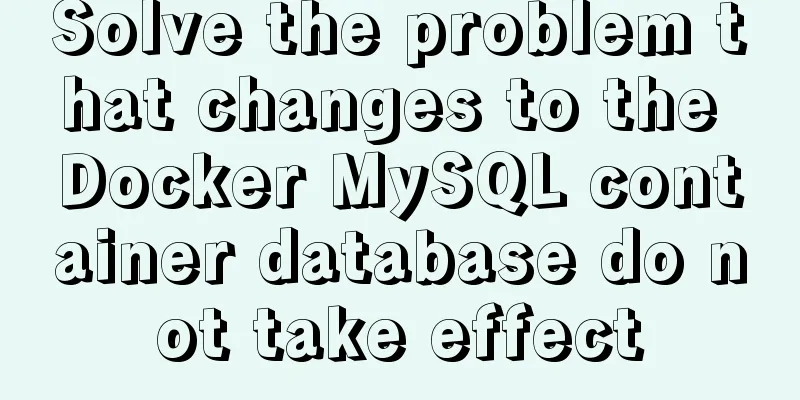Solve the problem that changes to the Docker MySQL container database do not take effect

|
Using the official MySQL image requires some modifications, such as configuration files, DB data file directories, etc. If you re-run the container after the changes, the modified files will be invalid, and the newly generated container will not have the previously changed content. The first is to modify the image downloaded by the official website, and then submit a new image file docker commit -m and other newly generated image information. The second type of MYSQL DB data, if you restart the same container with docker restart after the container is closed, the data will be normal. If you re-docker run the container, the data will not be displayed because each container has a file address This requires mounting the data file for other containers to read. Start the mysql container in docker, make changes to the database in the mysql container (such as creating a database, changing data, etc.), and enter the container again after committing to find that all previous changes have not been saved 1. Run the mysql container in the background and set the container name to mysql:
2. Enter the container bash and mysql, create a database TEST_DB, and verify that TEST_DB is created successfully: [root@localhost ~]# docker exec -it mysql bash root@f80791a0daf1:/# mysql -uroot -p show databases; create database TEST_DB; 3. Exit the container and commit the changes to the image: This data is actually modified on the host machine, not in the MySQL image. So it doesn't work mysql> exit Bye root@f80791a0daf1:/# exit exit [root@localhost ~]# docker commit mysql owenchen1992/mysql 4. Restart the container and enter bash and mysql. You will find that the TEST_DB created previously is gone, indicating that the previous changes are invalid: [root@localhost ~]# docker container stop mysql mysql [root@localhost ~]# docker container rm mysql mysql [root@localhost ~]# docker run --name=mysql -p 3306:3306 -d owenchen1992/mysql a1a1b4174caaadda0ec4b01b9fe5f92d6b3464d85284042274f71aebde0915dd [root@localhost ~]# docker exec -it mysql bash root@a1a1b4174caa:/#mysql -uroot -p Enter password: Welcome to the MySQL monitor. Commands end with ; or \g. Your MySQL connection id is 3 Server version: 5.7.20 MySQL Community Server (GPL) mysql> show databases; +--------------------+ | Database | +--------------------+ | information_schema | |mysql | | performance_schema | |sys| +--------------------+ 4 rows in set (0.00 sec) Cause of the problem: In the MySQL Dockerfile there is a line like this:
This means that all modifications to the directory /var/lib/mysql in the container will be mapped to a certain location on the host. You can view the specific corresponding host directory through the command: docker inspect containerID/name. When running docker commit, changes to the /var/lib/mysql directory in the container are not committed to the image, but these changes are synchronized with the corresponding directory on the host at any time. When you restart the committed image, the container will create a new directory on the host to save its data updates. Therefore, it is not the original host directory, so the newly opened container cannot see the previous data changes. Solution: Now that we know the cause of the problem, it is not difficult to solve it. The steps are as follows: You can go directly to this directory to view the data directory generated for each container 1. Find the host directory corresponding to the mysql container "/var/lib/docker/volumes/8496bbf33782bdadc027cdcf23197e5ebc36d11deb69ee833d63b557b3a7183d/_data":
[root@localhost ~]# docker inspect mysql
[
......
"Source": "/var/lib/docker/volumes/8496bbf33782bdadc027cdcf23197e5ebc36d11deb69ee833d63b557b3a7183d/_data",
"Destination": "/var/lib/mysql",
......
]Repeat the previous steps of creating a container and running it, run a new container, and then create a TEST table. First close the container and then delete the container service. 4. Run the new container in the background, mount the directory corresponding to the host machine to the /var/lib/mysql directory of the container and enable read and write permissions (key steps):
5. Now enter the newly opened container and check the database: it is found that the database TEST_DB just created does not disappear due to re-running the container, and the problem is solved The steps are: 1. Create a new table, 2. Shut down the container for creating the table, 3. Re-run the container and mount the data directory to /var/lib/mysql, and the problem is solved! Supplementary knowledge: How to modify the encoding format when using MySQL in a docker environment Method 1 (for single machine modification) First make sure the mysql service is started Type docker exec -it + service name/bin/bash to enter the console Type apt-get update command Type apt-get install vim (the above two commands are used to download the vim editor), Enter the vim /etc/mysql/mysql.conf.d/mysqld.cnf command to enter the mysqld.cnf file 4. Use i to open the edit mode and enter the following at the end of the text: Note: The following content must not be entered incorrectly, otherwise the configuration file will become invalid. [client] default-character-set=utf8 [mysql] default-character-set=utf8 [mysqld] character-set-server=utf8 Press ESC to exit, and press shift+colon wq to save and exit. 5. Enter the mysql console 6. Enter show variables like 'char%'; to view the modified corresponding information
After the modification is completed and the database is restarted: enter show variables like "char%"
The above results indicate that the modification has been successful. Method 2 (applicable to cluster construction) Copy the configuration file out of the original directory and modify it using an external file. This method is used to send files to multiple servers to modify the database default encoding. docker exec -it + service name/bin/bash to enter the console Enter cd /etc/mysql/conf.d/ to enter the configuration file directory Enter pwd to get the absolute path of the file Enter cd to return to the console, exit Enter docker cp service name:/etc/mysql/conf.d/mysql.cnf /usr/soft (copy the mysql.cnf file in docker to the soft folder under linux) Open an external editor (such as notepad++) and write the configuration file as follows: [client] default-character-set=utf8 [mysql] default-character-set=utf8 [mysqld] init_connect = 'SET collation_connection = utf8_unicode_ci' init_connect='SET NAMES utf8' character-set-server=utf8 collation-server=utf8_unicode_ci skip-character-set-client-handshake
PS: It is important to note that there should be spacing between the contents of the configuration file. Save well 7.docker cp /usr/soft/mysql.cnf Service name: /etc/mysql/conf.d/ Copy the modified file to the original directory and overwrite it 8. Restart the mysql service in docker, then 9. Enter the show variables like 'char%' command to view the modified character encoding format The above article on solving the problem of Docker MySQL container database changes not taking effect is all the content that the editor shares with you. I hope it can give you a reference, and I also hope that you will support 123WORDPRESS.COM. You may also be interested in:
|
<<: Table paging function implemented by Vue2.0+ElementUI+PageHelper
Recommend
Detailed explanation of how to use Node.js to implement hot reload page
Preface Not long ago, I combined browser-sync+gul...
Detailed tutorial on replacing mysql8.0.17 in windows10
This article shares the specific steps of replaci...
A brief discussion on using Cartesian product principle to query multiple tables in MySQL
MySQL multi-table query (Cartesian product princi...
How to do a good refactoring is not only refactoring the code but also refactoring life
It is really not easy to do a good reconstruction...
MySQL database operations and data types
Table of contents 1. Database Operation 1.1 Displ...
Use Html+Css to implement a simple navigation bar function (the navigation bar switches the background color when the mouse is encountered)
Ⅰ. Problem description: Use html+css to implement...
Detailed explanation of the Docker container lifecycle architecture and the differences between it and VM
Container lifecycle The life cycle of a container...
Analysis of the new features of MySQL 8.0 - transactional data dictionary and atomic DDL
Preface Transactional data dictionary and atomic ...
Vue development tree structure components (component recursion)
This article example shares the specific code of ...
Implementation of FIFO in Linux process communication
FIFO communication (first in first out) FIFO name...
MySQL query statement simple operation example
This article uses examples to illustrate the simp...
Detailed tutorial on installing JDK8 on Linux system (CentOS7 installation)
JDK Installation I won't go into too much det...
Detailed explanation of MySQL persistent statistics
1. The significance of persistent statistical inf...
Analysis of implicit bug in concurrent replication of MySQL 5.7
Preface Most of our MySQL online environments use...
HTML+CSS realizes scrolling to the element position to display the loading animation effect
How to add a loading animation every time I scrol...












